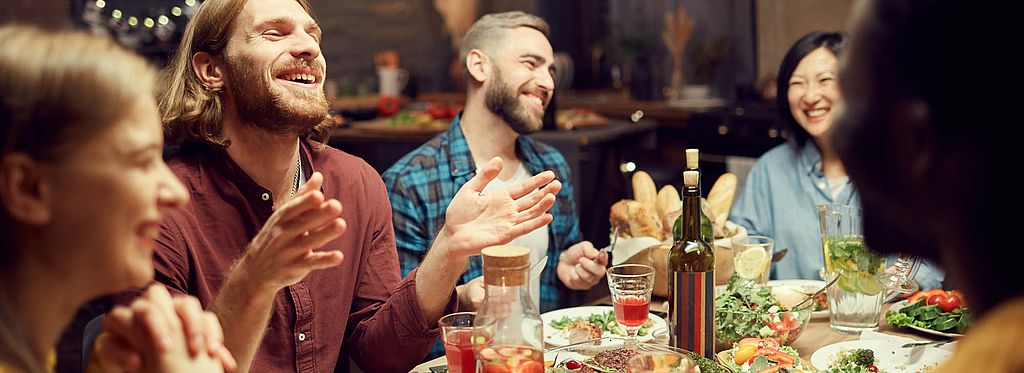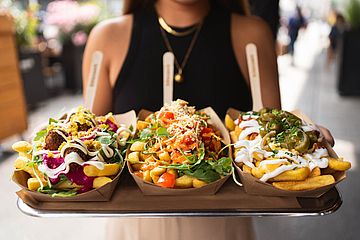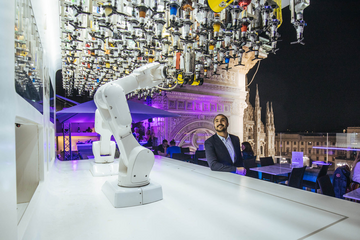Emotions are Key
Emotions are the driving force that moves people and the key to innovation, connection and success. Food is highly emotional, personal and often even intimate, deeply rooted in our memories and experiences and strengthens social bonds as a shared ritual.
This is precisely where a great opportunity lies: when a visit to a restaurant becomes a unique experience, it awakens emotions and stays in mind. But how can this be implemented ? From the food and drinks themselves, the design and atmosphere in the restaurant to the service staff – the aspects that contribute to an emotional experience are various and comprehensive.
Impulses for implementation in the out-of-home market
- Storytelling can support the emotional experience and strengthen guest loyalty. The possibilities range from focusing on the history of the restaurant and the owners to narrate about the ingredients, seasonal highlights and sustainability.
- Emotions can be evoked through special presentation – from food and drinks to restaurant design, for example through
- Special presentation in unusual containers, glasses, set-ups
- Star components such as stracciatella di mozzarella
- Visual effects such as smoke using dry ice or smoking devices
- Movement through thermal effects such as seen with bonito flakes
- Live cooking
At INTERNORGA, you will not only find inspiration for this, but also exhibitors who can help with emotional presentation: Franke-Filter GmbH NatureRooms, for example, makes eye-catching room design with living moss walls. Wooden barrels from Das Holzfass von Walter Keitel – Die Tischlermeister create special guest experiences and can be used in a variety of ways, for example as a catering or snooze barrel. For INTERNORGA 2025, Salomon Food World © GmbH has a high-convenience innovation in store that enhances the emotional experience of enjoyment. Deeken raumconzepte is providing support with impressive interior design. Inspiration for special table designs can be found at the Skywalk Table and from exhibitors such as BHS tabletop.
Street food around the Globe
Street food fascinates with its international, vibrant variety and is more dynamic and changeable than almost any other sector. It is fast, practical and can therefore also pick up on short-term trends. The variety ranges from simple, cool offerings to high-end creations that can even be found in fine dining and Michelin-starred restaurants. With constantly new influences, a variety of flavours and creative recipes, it connects cultures across national borders and responds to guests' need for new experiences and tastes. It serves the mega-trend of snacking in an uncomplicated way. Street food acts as a ‘playground for testing’ so that new trends and creative recipes can be tried out in small portions – by guests and restaurants alike.
Impulses for implementation in the out-of-home market
- New creations of popular classics such as rice pudding create new flavour experiences, awakening memories and curiosity at the same time.
- Popular favourites such as pizza, kebab and chips are developed further and, as with loaded fries, can develop into hype.
- Mono concepts focus on the powerful presentation of one food or drink, while at the same time offering a wide range of variations of it.
- One-hand snacks, including further developments of classics such as sushi or pizza, are becoming increasingly popular due to new lifestyles, as they are ‘smartphone compatible’.
- The demand for vending machines that provide guests with fresh snacks 24/7 is increasing.
Numerous exhibitors at INTERNORGA 2025 will be showcasing the latest developments in street food and snacks for the out-of-home market. For example at Bakerman, Salomon Food World © GmbH, Lamb Weston EMEA and Farm Frites you can taste the latest trends in street food live on site and exchange relevant industry expertise at the same time.
Food Architecture of the Cities
Despite possible challenges, the current situation in many German city centres – between vacant properties and falling visitor numbers – also offers opportunities for the out-of-home market, particularly for gastronomy as ‘social glue’. This is because many cities are intensively looking for solutions to counteract vacancies. This promotes opportunities to rethink and take innovative, creative paths.
Whether successfully established or currently challenged concept: regarding current developments and opportunities, it is worth examining the status quo and sharpening the concept if necessary. A clear concept, unique key products and storytelling will strengthen companies for the future. It is also important to examine and recalculate how digitalisation with innovative technologies such as AI and robotics could make the concept even more successful and resilient.
Impulses for implementation in the out-of-home market
- Rethink usage formats: dual or multiple use can enrich the visitor experience, increase sustainability and efficiency and provide economic support.
- Old, historic buildings with a special charm can enable unique concepts with a special atmosphere and storytelling.
- In addition to chain stores, malls also offer space for unique concepts from individual gastronomy businesses. They strengthen an individualised appearance and are a relevant driver for malls, because shopping makes guests hungry and snacks and meals offer a welcome change.
- Digitalisation with AI can help to counteract the shortage of staff and to optimise processes – the possibilities are becoming increasingly diverse.
The trends of tomorrow can be experienced live today at INTERNORGA. In Halls A2 and A3, focused on Digital Applications, numerous exhibitors will be showing how digitalisation can support the out-of-home market and enrich the guest experience. For example, you will find autonomous service and cleaning robots at Giobotics and digital solutions specifically for the hotel industry at Casablanca Hotelsoftware. Kamasys offers an extensive portfolio, from lunch apps for canteens, digital menus and plate scanners to service robots, vending machine catering and merchandise management as well as ordering systems.
Healthy World Update
Growing health awareness is one of the megatrends that will characterise the out-of-home market in the long term. Plantarianism, i.e. a more plant-orientated diet with a simultaneous decline in the consumption of meat, poultry, fish and dairy products, continues to grow and is supported by impulses from the vegan and vegetarian diets. The growing variety of protein alternatives has the potential to revolutionise the market – with new taste experiences that cater to individual needs. According to the latest findings, products based on sunflower protein and lupins stand out in particular, leading the way in terms of sustainability and protein content. In the drinks sector, the range of no- and low-alcohol alternatives is constantly evolving: the increasing range and improved quality of non-alcoholic alternatives enable full enjoyment without compromise.
Impulses for implementation in the out-of-home market
- Authentic regionality with storytelling according to the motto ‘Do good and talk about it’ can inspire new creations, increase variety and strengthen guest loyalty.
- Role reversal: Plant-based ingredients are increasingly taking centre stage, while meat is sometimes offered as an (optional) side dish.
- In community catering and healthy gastronomy concepts in particular, it can be helpful to follow the Planetary Health Diet.
- Plant-based protein alternatives can be used instead of meat – these achieve significantly better values than meat and poultry in terms of sustainability and often also protein level. It can be helpful to use convenience products made from protein alternatives that make it easy to switch from meat-based to plant-based products, such as sunflower mince, to reduce the workload on the kitchen and production. It is important to pay attention to good sensory properties, especially flavour.
- The checklist of the top 12 protein-rich protein alternatives will help choose the right plant-based protein alternatives.
Experience plant-based inspiration live at INTERNORGA 2025, for example at the new Future Food trend area. Here, exhibitors such as Verrano, BettaF!sh, Neggst, Vanozza, Rival Foods, Nomoo, Vly and Oatly will be demonstrating impressively how food will be organised in the out-of-home market of tomorrow. For the first time at INTERNORGA 2025, endori and Rügenwalder Mühle are joining forces for vegan convenience dishes in food service. Also, you can try alcohol-free alternatives from exhibitors such as Franz von Fein, Dr Jaglas and Freikopf.
Recommendation for Action: Courage & Efficiency
Numerous challenges such as price sensitivity due to inflation, increased costs, staff shortages and complex bureaucratic challenges are currently characterising the situation in the out-of-home market. In the midst of these times, courage and efficiency play an important role when it comes to emerging from crises stronger and fit for the future.
Among other things, the 7 Courage Strategies© by food & more show numerous approaches that can help analyse and examine the individual situation. The effects on efficiency that the courage approaches entail become clear. Individually or in combination, they provide inspiration to take new paths or adjust existing ones and turn challenges into opportunities. Now is the time for courage and efficiency – and therefore both for innovation and for rethinking and sharpening concepts in order to optimise the use of resources and increase efficiency.
#1 Courage to ‘outbursts of courage’!
Those who act courageously can set a powerful course for a successful future, even in challenging times.
#2 Courage to change perspective!
It can help to look at stuck ways of working and thinking through different ‘glasses’ and thus find new solutions.
#3 Courage to take on new leadership responsibilities!
A value-oriented and empathetic management culture promotes dialogue with employees and creates a strong ‘we culture’ that not only experiences highs together, but also masters lows.
#4 Courage for self-efficacy!
Active behaviour strengthens dynamism, power and self-confidence.
#5 Courage to be a role model!
Acting as a role model means being a role model in daily actions, attitude, authenticity and cooperation with the team and setting an example of positive values that can be passed on to employees.
#6 Courage to ‘change culture’!
An open error culture views failures as valuable learning opportunities and promotes a more innovative, risk-taking, open-minded mindset and continuous further development.
#7 Courage for the digiverse!
Digitalisation with AI has developed into its own universe (= digiverse) and offers new opportunities for innovative solutions to optimise processes, work more efficiently and reduce errors.




